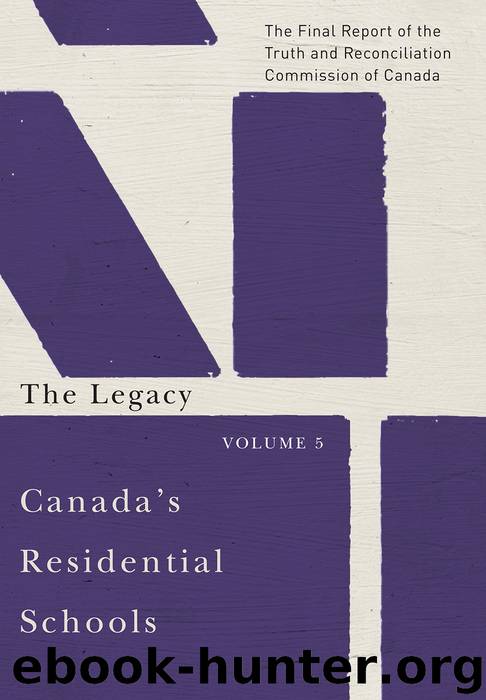Canada's Residential Schools by Truth and Reconciliation Commission of Canada

Author:Truth and Reconciliation Commission of Canada
Language: eng
Format: epub
Publisher: MQUP
Published: 2016-06-15T00:00:00+00:00
The report drew attention to an important gap in the government’s ADR program—namely, the absence of an Aboriginal perspective. The report stated that true reconciliation and healing would be possible if the AFN’S recommended changes to the ADR program were followed.111
The AFN report recommended a “two-prong strategy.” One prong would focus on compensation and the other on “truth-telling, healing and public education.” The compensation part would include “a significant lump sum award” to every person who attended residential school “to compensate for the loss of language and culture,” combined with another sum tied to each year or part of the year spent in residential school to “recognize emotional harms, including the loss of family life and parental guidance, neglect, depersonalization, denial of a proper education, forced labour, inferior nutrition and health care, and growing up in a climate of fear, apprehension, and ascribed inferiority. As a rule, no adjudication should be necessary for these awards to be made.”112
The second truth-telling and healing track would include “a voluntary truth-sharing and reconciliation process designed to investigate the nature, causes, context and consequences of all the harms resulting from the residential schools legacy. This would include, but not be limited to, harms to individual Survivors, First Nations communities, Survivors’ families, the future generations, culture, spirituality, language and relationships between and among all parties involved.”113 This recommendation, like those made by groups of Survivors in the early 1990s and subsequently by the Royal Commission on Aboriginal Peoples in 1996 focused on the collective harms of residential schools and collective responses to those harms—a significant contrast to the relentlessly individualistic focus of the litigation that excluded compensation for students who had died and for the children of Survivors.
The inadequacies of the ADR process were also revealed in hearings conducted in February 2005 by the House of Common’s Standing Committee on Aboriginal Affairs and Northern Development. They heard from Flora Merrick, an eighty-eight-year-old Elder whose $1,500 ADR award was being appealed by the federal government. The issue was whether she should be compensated for “being strapped so severely that my arms were black and blue for several weeks” and for being “locked in a dark room for about two weeks” after she ran away from Portage la Prairie residential school. Merrick explained that she was willing
to accept the $1,500 award, not as a fair and just settlement, but only due to my age, health, and financial situation. I wanted some closure to my residential school experience, and I could use the money, even as small as it was. I am very angry and upset that the government would be so mean-spirited as to deny me even this small amount of compensation … I’m very upset and angry, not only for myself, but also for all residential school survivors.114
Download
This site does not store any files on its server. We only index and link to content provided by other sites. Please contact the content providers to delete copyright contents if any and email us, we'll remove relevant links or contents immediately.
| African-American Studies | Asian American Studies |
| Disabled | Ethnic Studies |
| Hispanic American Studies | LGBT |
| Minority Studies | Native American Studies |
Cecilia; Or, Memoirs of an Heiress — Volume 1 by Fanny Burney(32495)
Cecilia; Or, Memoirs of an Heiress — Volume 2 by Fanny Burney(31909)
Cecilia; Or, Memoirs of an Heiress — Volume 3 by Fanny Burney(31888)
The Great Music City by Andrea Baker(31756)
We're Going to Need More Wine by Gabrielle Union(19003)
All the Missing Girls by Megan Miranda(15770)
Pimp by Iceberg Slim(14433)
Bombshells: Glamour Girls of a Lifetime by Sullivan Steve(14020)
For the Love of Europe by Rick Steves(13531)
Talking to Strangers by Malcolm Gladwell(13288)
Norse Mythology by Gaiman Neil(13274)
Fifty Shades Freed by E L James(13185)
Mindhunter: Inside the FBI's Elite Serial Crime Unit by John E. Douglas & Mark Olshaker(9260)
Crazy Rich Asians by Kevin Kwan(9217)
The Lost Art of Listening by Michael P. Nichols(7452)
Enlightenment Now: The Case for Reason, Science, Humanism, and Progress by Steven Pinker(7272)
The Four Agreements by Don Miguel Ruiz(6697)
Bad Blood by John Carreyrou(6581)
Weapons of Math Destruction by Cathy O'Neil(6213)
